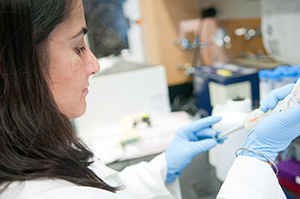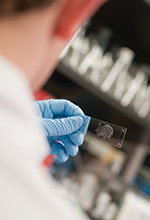March 2, 2015:

Leonidas Platanias, MD, PhD, director of the Robert H. Lurie Comprehensive Cancer Center of Northwestern University
Q: What kind of impact do you see the Big Ten Cancer Research Consortium having on cancer clinical trials?
Our member institutions each have unique strengths and resources; the Big Ten Cancer Research Consortium (Big Ten CRC) provides the necessary structure to use those resources to the best advantage and expedite the development of effective, innovative clinical research. The consortium’s ability to streamline processes from clinical trial design to implementation expands opportunities for our cancer centers to make the most of limited funding. In addition, the Big Ten CRC’s focus on collaboration will help ensure that young investigators receive mentorship and support to advance their concepts and develop new therapies.
Q: What are some of the strengths that the Lurie Cancer Center brings to the consortium?
The Lurie Cancer Center’s research programs are organized around the strengths of our members, providing the structure for interdisciplinary teamwork and mentorship around specific research disciplines or disease types. Among our strengths, Northwestern’s Quantitative Imaging Core Lab (QICL) offers the expertise of the world’s leading experts in radiology and interventional oncology combined with the ability to deliver consistent, standardized, high-quality medical image analysis. This makes the QICL an ideal partner for clinical research trials. Currently the QICL analyzes medical images for more than 50 oncologic clinical trials, including Phase I clinical trials, providing a comprehensive set of quantitative imaging services for evaluation of responses to cancer therapies.
 The launch of Northwestern Medicine Developmental Therapeutics Institute, along with the Lurie Cancer Center’s collaborative research programs in academia and industry, are important elements of our initiatives focused on the translation of molecular biology into the delivery of personalized medicine. For instance, the disease-specific expertise of our faculty members dedicated to developmental therapeutics, supports the progress of investigator-initiated studies that we can also bring to the consortium.
The launch of Northwestern Medicine Developmental Therapeutics Institute, along with the Lurie Cancer Center’s collaborative research programs in academia and industry, are important elements of our initiatives focused on the translation of molecular biology into the delivery of personalized medicine. For instance, the disease-specific expertise of our faculty members dedicated to developmental therapeutics, supports the progress of investigator-initiated studies that we can also bring to the consortium.
Q: What kind of scientific developments happening at the Lurie Cancer Center are changing the way that we diagnose and treat cancer?
We are very excited about our expanding research programs to realize the potential of precision medicine. For example, the multidisciplinary Northwestern Onco-SET (Sequence, Evaluate, Treat) Program will use molecularly defined genomic targets as a basis for determining treatment options including novel early-phase clinical trials. As part of our work with Onco-SET, we are also planning to initiate a pilot program of site-agnostic, pathway-driven tumor clinics. Onco-SET will provide the environment and infrastructure in which we can deliver personalized cancer treatment for patients who currently have very limited options, while accelerating our other research focused on developing novel individually tailored agents.
The Cancer Control and Survivorship Research Program, along with our newly established Cancer Survivorship Institute, continue to lead the way in implementing state of the art and technology-based PROMIS measurement to assess distress and other patient reported outcomes (PROs). Electronic medical record integration and ongoing PRO assessments provide a unique opportunity to capture symptom burden and guide precision care for a variety of symptoms that may otherwise not be recognized, and therefore optimize health related quality of life outcomes.
Q: How will being a part of the Big Ten CRC differ from other collaborative efforts of which your center has been a part?
 Collaboration is an essential part of our overall approach to medical research. In the current research arena and the reduction of funding opportunities, it is imperative. The Big Ten CRC represents a great opportunity for collaboration with leading cancer centers and faculty with considerable expertise and experience, as well as for streamlining our efforts. Most clinical trials are designed to run at multiple institutions, and you really need a strong supporting infrastructure to make that efficient.
Collaboration is an essential part of our overall approach to medical research. In the current research arena and the reduction of funding opportunities, it is imperative. The Big Ten CRC represents a great opportunity for collaboration with leading cancer centers and faculty with considerable expertise and experience, as well as for streamlining our efforts. Most clinical trials are designed to run at multiple institutions, and you really need a strong supporting infrastructure to make that efficient.
Participation in the consortium helps us all make a unified effort to develop the careers of our junior faculty, and benefit from the senior faculty who can enhance mentorship not only within our own organizations, but also within the other member institutions.
About the Big Ten Cancer Research Consortium: The Big Ten Cancer Research Consortium creates a unique team-research culture to drive science rapidly from ideas to treatment-changing paradigms. Within this innovative environment, today’s research leaders collaborate with and mentor the research leaders of tomorrow with the unified goal of improving the lives of all patients with cancer.
About the Big Ten Conference: The Big Ten Conference is an association of world-class universities whose member institutions share a common mission of research, graduate, professional, and undergraduate teaching and public service. Founded in 1896, the Big Ten has sustained a comprehensive set of shared practices and policies that enforce the priority of academics in student-athletes’ lives and emphasize the values of integrity, fairness, and competitiveness. The broad-based athletic programs of the 14 Big Ten institutions provide nearly $200 million in direct financial aid to almost 9,500 student-athletes for more than 11,000 participation opportunities on 350 teams in 42 different sports. The Big Ten sponsors 28 official conference sports, 14 for men and 14 for women, including the addition of men’s and women’s lacrosse as official sports for the 2014-15 academic year. For more information, visit www.bigten.org.














Subscribe to the Big Ten CRC Newsletter X
X Facebook
Facebook YouTube
YouTube